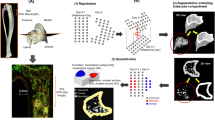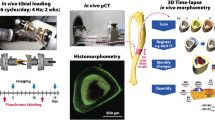Abstract
Dickkopf-1 (DKK1) and sclerostin are antagonists of the Wnt/β-catenin pathway and decreased expression of either results in increased bone formation and mass. As both affect the same signaling pathway, we aimed to elucidate the redundancy and/or compensation of sclerostin and DKK1. Weekly sclerostin antibody (Scl-Ab) was used to treat 9-week-old female Dkk1 KO (Dkk1−/−:Wnt3+/−) mice and compared to Scl-Ab-treated wild-type mice as well as vehicle-treated Dkk1 KO and wild-type animals. While Wnt3 heterozygote (Wnt3+/−) mice show no bone phenotype, Scl-Ab and vehicle-treated control groups of this genotype were included. Specimens were harvested after 3 weeks for microCT, bone histomorphometry, anti-sclerostin immunohistochemistry, and biomechanical testing. Scl-Ab enhanced bone anabolism in all treatment groups, but with synergistic enhancement seen in the cancellous compartment of Dkk1 KO mice (bone volume + 55% Dkk1 KO p < 0.01; + 22% wild type p < 0.05). Scl-Ab treatment produced less marked increases in cortical bone of the tibiae, with anabolic effects similar across genotypes. Mechanical testing confirmed that Scl-Ab improved strength across all genotypes; however, no enhancement was seen within Dkk1 KO mice. Dynamic bone labeling showed that Scl-Ab treatment was associated with increased bone formation, regardless of genotype. Immunohistochemical staining for sclerostin protein indicated no differences in the Dkk1 KO mice, indicating that the increased Wnt signaling associated with DKK1 deficiency was not compensated by upregulation of sclerostin protein. These data suggest complex interactions between Wnt signaling factors in bone, but critically illustrate synergy between DKK1 deficiency and Scl-Ab treatment. These data support the application of dual-targeted therapeutics in the modulation of bone anabolism.




Similar content being viewed by others
References
Krishnan V, Bryant HU, Macdougald OA (2006) Regulation of bone mass by Wnt signaling. J Clin Invest 116(5):1202–1209
Robling AG, Niziolek PJ, Baldridge LA, Condon KW, Allen MR, Alam I et al (2008) Mechanical stimulation of bone in vivo reduces osteocyte expression of Sost/sclerostin. J Biol Chem 283(9):5866–5875
Li J, Sarosi I, Cattley RC, Pretorius J, Asuncion F, Grisanti M et al (2006) Dkk1-mediated inhibition of Wnt signaling in bone results in osteopenia. Bone 39(4):754–766
Guo J, Liu M, Yang D, Bouxsein ML, Saito H, Galvin RJ et al (2010) Suppression of Wnt signaling by Dkk1 attenuates PTH-mediated stromal cell response and new bone formation. Cell Metab 11(2):161–171
Yao GQ, Wu JJ, Troiano N, Insogna K (2011) Targeted overexpression of Dkk1 in osteoblasts reduces bone mass but does not impair the anabolic response to intermittent PTH treatment in mice. J Bone Miner Metab 29(2):141–148
Loots GG, Kneissel M, Keller H, Baptist M, Chang J, Collette NM et al (2005) Genomic deletion of a long-range bone enhancer misregulates sclerostin in Van Buchem disease. Genome Res 15(7):928–935
Rhee Y, Allen MR, Condon K, Lezcano V, Ronda AC, Galli C et al (2011) PTH receptor signaling in osteocytes governs periosteal bone formation and intracortical remodeling. J Bone Miner Res 26(5):1035–1046
Winkler DG, Sutherland MK, Geoghegan JC, Yu C, Hayes T, Skonier JE et al (2003) Osteocyte control of bone formation via sclerostin, a novel BMP antagonist. EMBO J 22(23):6267–6276
MacDonald BT, Joiner DM, Oyserman SM, Sharma P, Goldstein SA, He X et al (2007) Bone mass is inversely proportional to Dkk1 levels in mice. Bone 41(3):331–339
Kramer I, Kneissel M (2008) The high bone mass phenotype of Sost deficient mice is characterized by progressive increase in bone thickness, mineralization and predicted cortical bone strength in a gene dosage unrelated manner. Bone 42(Supplement 1):S57
Li X, Ominsky MS, Niu QT, Sun N, Daugherty B, D’Agostin D et al (2008) Targeted deletion of the sclerostin gene in mice results in increased bone formation and bone strength. J Bone Miner Res 23(6):860–869
McDonald MM, Morse A, Schindeler A, Mikulec K, Peacock L, Cheng T et al (2017) Homozygous Dkk1 knockout mice exhibit high bone mass phenotype due to increased bone formation. Calcif Tissue Int 102:105–116
Staehling-Hampton K, Proll S, Paeper BW, Zhao L, Charmley P, Brown A et al (2002) A 52-kb deletion in the SOST-MEOX1 intergenic region on 17q12-q21 is associated with van Buchem disease in the Dutch population. Am J Med Genet 110(2):144–152
Balemans W, Ebeling M, Patel N, Van Hul E, Olson P, Dioszegi M et al (2001) Increased bone density in sclerosteosis is due to the deficiency of a novel secreted protein (SOST). Hum Mol Genet 10(5):537–543
Gardner JC, van Bezooijen RL, Mervis B, Hamdy NA, Lowik CW, Hamersma H et al (2005) Bone mineral density in sclerosteosis; affected individuals and gene carriers. J Clin Endocrinol Metab 90(12):6392–6395
Chang MK, Kramer I, Keller H, Gooi JH, Collett C, Jenkins D et al (2013) Reversing LRP5-dependent osteoporosis and SOST-deficiency induced sclerosing bone disorders by altering WNT signaling activity. J Bone Miner Res 29:29–42
van Lierop A, Moester M, Hamdy N, Papapoulos S (2013) Serum dickkopf 1 levels in sclerostin deficiency. J Clin Endocrinol Metab 99:E252–E256
Florio M, Gunasekaran K, Stolina M, Li X, Liu L, Tipton B et al (2016) A bispecific antibody targeting sclerostin and DKK-1 promotes bone mass accrual and fracture repair. Nat Commun 7:11505
Ominsky MSR, Jolette J et al (2012) Long-term sclerostin antibody treatment in cynomolgus monkeys: sustained improvements in vertebral microarchitecture and bone strength following a temporal increase in cancellous bone formation. J Bone Miner Res 27(S1):S124
van Lierop AH, Hamdy NA, Hamersma H, van Bezooijen RL, Power J, Loveridge N et al (2011) Patients with sclerosteosis and disease carriers: human models of the effect of sclerostin on bone turnover. J Bone Miner Res 26(12):2804–2811
Lewis SL, Khoo PL, De Young RA, Steiner K, Wilcock C, Mukhopadhyay M et al (2008) Dkk1 and Wnt3 interact to control head morphogenesis in the mouse. Development 135(10):1791–1801
Mukhopadhyay M, Shtrom S, Rodriguez-Esteban C, Chen L, Tsukui T, Gomer L et al (2001) Dickkopf1 is required for embryonic head induction and limb morphogenesis in the mouse. Dev Cell 1(3):423–434
Liu P, Wakamiya M, Shea MJ, Albrecht U, Behringer RR, Bradley A (1999) Requirement for Wnt3 in vertebrate axis formation. Nat Genet 22(4):361–365
Chandra A, Lin T, Young T, Tong W, Ma X, Tseng WJ et al (2017) Suppression of sclerostin alleviates radiation-induced bone loss by protecting bone-forming cells and their progenitors through distinct mechanisms. J Bone Miner Res 32(2):360–372
Morse A, Schindeler A, McDonald MM, Kneissel M, Kramer I, Little DG (2017) Sclerostin antibody augments the anabolic bone formation response in a mouse model of mechanical tibial loading. J Bone Miner Res 33:486–498
Morse A, McDonald MM, Kelly NH, Melville KM, Schindeler A, Kramer I et al (2014) Mechanical load increases in bone formation via a sclerostin-independent pathway. J Bone Miner Res 29(11):2456–2467
Moustafa A, Sugiyama T, Prasad J, Zaman G, Gross T, Lanyon L et al (2011) Mechanical loading-related changes in osteocyte sclerostin expression in mice are more closely associated with the subsequent osteogenic response than the peak strains engendered. Osteoporos Int 23:1–10
Lynch ME, Main RP, Xu Q, Walsh DJ, Schaffler MB, Wright TM et al (2010) Cancellous bone adaptation to tibial compression is not sex dependent in growing mice. J Appl Physiol 109(3):685–691
Fritton JC, Myers ER, Wright TM, van der Meulen MC (2005) Loading induces site-specific increases in mineral content assessed by microcomputed tomography of the mouse tibia. Bone 36(6):1030–1038
Li X, Grisanti M, Fan W, Asuncion FJ, Tan HL, Dwyer D et al (2011) Dickkopf-1 regulates bone formation in young growing rodents and upon traumatic injury. J Bone Miner Res 26(11):2610–2621
McClung MR, Grauer A, Boonen S, Bolognese MA, Brown JP, Diez-Perez A et al (2014) Romosozumab in postmenopausal women with low bone mineral density. N Engl J Med 370:412–420
Recker RR, Benson CT, Matsumoto T, Bolognese MA, Robins DA, Alam J et al (2015) A randomized, double-blind phase 2 clinical trial of blosozumab, a sclerostin antibody, in postmenopausal women with low bone mineral density. J Bone Miner Res 30(2):216–224
Cosman F, Crittenden DB, Adachi JD, Binkley N, Czerwinski E, Ferrari S et al (2016) Romosozumab treatment in postmenopausal women with osteoporosis. N Engl J Med 375(16):1532–1543
Holdsworth G, Greenslade K, Jose J, Stencel Z, Kirby H, Moore A et al (2017) Dampening of the bone formation response following repeat dosing with sclerostin antibody in mice is associated with up-regulation of Wnt antagonists. Bone 107:93–103
McClung MRCA., Brown JP, Diez-Perez A, Resch H, Caminis J, Bolognese MA, Goemaere S, Bone HG, Zanchetta JR, Maddox J, Rosen O, Bray S, Grauer A (2015) OP0251 effects of 2 years of treatment with romosozumab followed by 1 year of denosumab or placebo in postmenopausal women with low bone mineral density. Ann Rheum Dis 74(Suppl 2):166–167
Author information
Authors and Affiliations
Contributions
Study design: AM, DGL, MMM, MK, IK. Study conduct: AM, TLC, SM. Data collection: AM, TLC. Data interpretation: AM, TLC, DGL. Drafting manuscript: AM. Revising manuscript content and approving final version of manuscript: all authors. AM takes responsibility for the integrity of the data analysis. We thank Lauren Peacock and Kathy Mikulec for their assistance in animal dosing. We thank Dr. Ciara Murphy for her assistance in developing methods for confocal imaging.
Corresponding author
Ethics declarations
Conflict of interest
The authors received materials support (Scl-Ab) for this study from Novartis Pharma AG (Basel, Switzerland) and Mereo BioPharma (London, UK). Prof Little has received additional funding and materials support from Novartis Pharma AG and Mereo BioPharma for pre-clinical research separate to this submission and is a consultant for Orthopediatrics. Prof Little and A/Prof Schindeler have received funding support from Amgen Inc., UCB Pharma, N8 Medical, and Celgene for pre-clinical research separate to this submission. Dr McDonald received salary support from the IBMS Greg Mundy Fellowship and receives a Practitioner Fellowship (National Health & Medical Research Council). Authors Dr Kneissel and Dr Kramer are employees of Novartis Pharma AG.
Human and Animal Rights and Informed Consent
Animal experiments were approved and performed under the Western Sydney LHD Animal Ethics Committee protocol 4174 and CMRI/CHW animal ethics protocol K338.
Electronic supplementary material
Below is the link to the electronic supplementary material.
Rights and permissions
About this article
Cite this article
Morse, A., Cheng, T.L., Schindeler, A. et al. Dkk1 KO Mice Treated with Sclerostin Antibody Have Additional Increases in Bone Volume. Calcif Tissue Int 103, 298–310 (2018). https://doi.org/10.1007/s00223-018-0420-6
Received:
Accepted:
Published:
Issue Date:
DOI: https://doi.org/10.1007/s00223-018-0420-6




